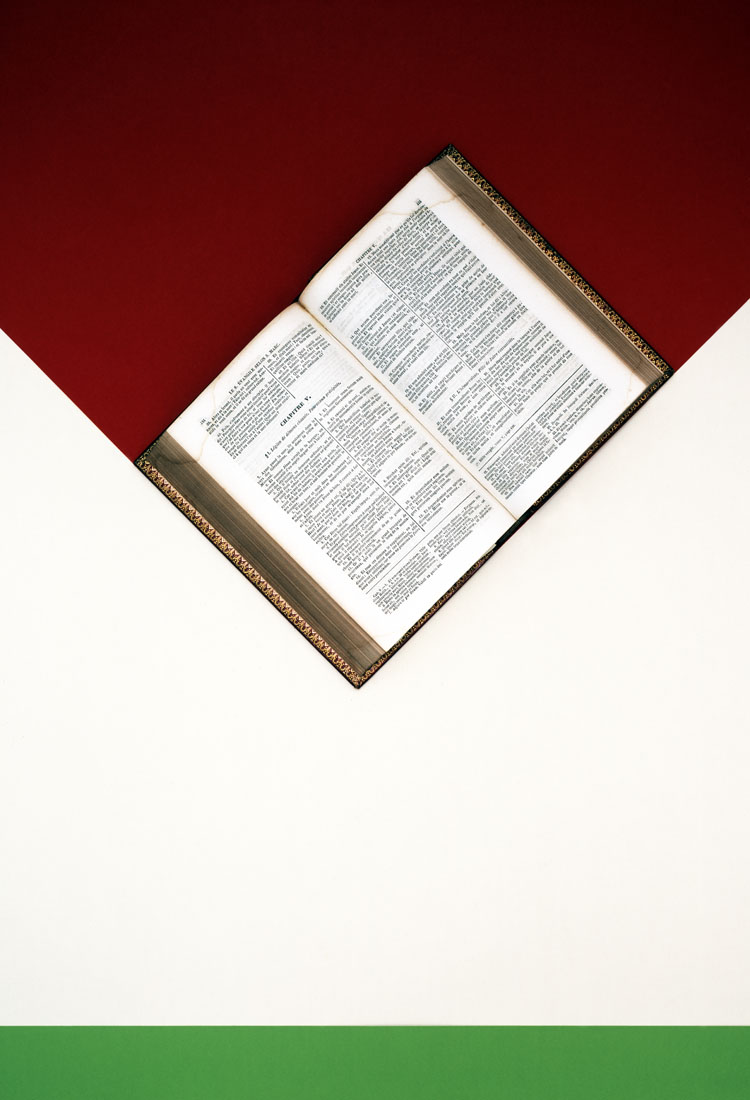La Bible
117 x 80 cm - 2003

L’étroitesse du monde
Le ciel rouge est une surface carrée infinie. Seul un angle pointé vers la terre est donné à voir et il se confond avec le livre sacré, son messager. Le rouge, lourd et ancien, rappelle le poids des siècles teintés par le sang du Christ. Le vert acidulé figure la terre au temps présent. Entre les deux couleurs, un espace blanc cassé demeure infranchissable parce que l’espace de la photographie forme un couloir vertical trop étroit. Dans un mouvement de descente, les bords de l’immense carré rouge butent sur les côtés gauche et droit du cadre. Certes, la pointe inférieure du livre indique une direction. Mais il ne descendra jamais plus bas. Le ciel reste au ciel. C’est l’homme qui doit franchir l’espace qui sépare la terre du ciel. Et non l’inverse. Les pages ouvertes sur le texte de l’Évangile apportent une clarté au centre de la composition. Les mots sont tournés vers le ciel et indiquent la voie. Mais le livre exerce une force duale dans la composition. Objet doré et alourdi par le sacré, il génère aussi une pesanteur, un mouvement vers l’ici-bas. C’est l’évocation d’une rencontre. Le texte de l’Évangile selon saint Marc raconte que Jésus rencontra un homme possédé. Ce dernier était si furieux qu’il parvint à briser ses chaînes pour venir à sa rencontre. Le nom de l’homme était « Légion » parce que les démons qui l’habitaient étaient nombreux. Il implora le fils de Dieu de ne pas le chasser de ce lieu. « Alors Jésus fit entrer ces esprits impurs dans les corps de pour- ceaux qui paissaient le long de la montagne. Les porcs qui étaient bien deux mille ne purent s’empêcher de courir vers la mer où ils se noyèrent tous. Alors l’homme fut enfin libéré de sa folie et Jésus le chargea de témoigner des grandes grâces qu’il avait reçues de lui. » A l’instar du Christ et de l’Homme, le rouge et le vert sont deux couleurs complémentaires qui s’attirent. Contrariée, cette attirance se fait ici synonyme du mystère de la foi. C’est à dire de ce que l’on n’aura jamais fini de comprendre puisque le ciel ne peut advenir sur la terre. La surface horizontale verte apparaît en effet terriblement fragile en contrebas du poids immense de la surface rouge qui pointe sur elle. Métaphore de l’esprit impur qui demeure prisonnier dans une étroite bande de vie acide et qui voit dans le ciel une menace. Pour s’élever, il doit d’abord être purifié. Délivré du poids des démons dont la chute était annoncée par le mouvement initial du Livre.
The Narrowness of the World
The red sky is an infinite square surface. Only a corner pointing towards the earth is visible and it merges with the holy book, its messenger. The red, heavy and ancient, recalls the weight of the centuries tinted by the blood of Christ. The acid green represents the earth in the present. Between both colours, an off-white space remains impassable because the space of the photograph forms a vertical corridor that is too narrow. In a downward movement, the edges of the huge red square come up against the left and right sides of the frame. The lower corner of the book does indeed point in a direction, but it will never go any lower. The sky remains skyward and it is man who must cross the space between earth and the heavens, and not vice versa. The open pages on the Gospel text bring clarity to the centre of the composition. The words face heavenwards and point the way. But the book exerts a dual force in the composition. A golden and sacred object, weighed down by the sacred: it also generates a heaviness, a movement towards the hereunder. It is the evocation of an encounter. The text of the Gospel according to Saint Mark tells us that Jesus met a man who was possessed. The man was so furious that he managed to break his chains to come and meet him. The man’s name was “Legion” because the demons in him were many. He begged the Son of God not to cast him out of that place. “So Jesus put these unclean spirits into the bodies of the pigs that were grazing on the mountain. The pigs, which numbered two thousand, could not help but run to the sea where they all drowned. Then the man was finally freed from his madness and Jesus charged him to testify of the great graces he had received from him”. Like Christ and the Man, red and green are two comple- mentary colours that attract each other. Counterpoised to this attraction, it is here synonymous with the mystery of faith. That is to say, of what we will never cease in compre- hending, since heaven cannot be on earth. The horizontal green surface appears terribly fragile below the immense weight of the red surface that points to it. This is a metaphor for the impure spirit which remains trapped in a narrow strip of acidic life and views the sky as a threat. To rise, it must first be purified: delivered from the weight of the demons whose fall was announced by the first movement of the Book. >>> Back